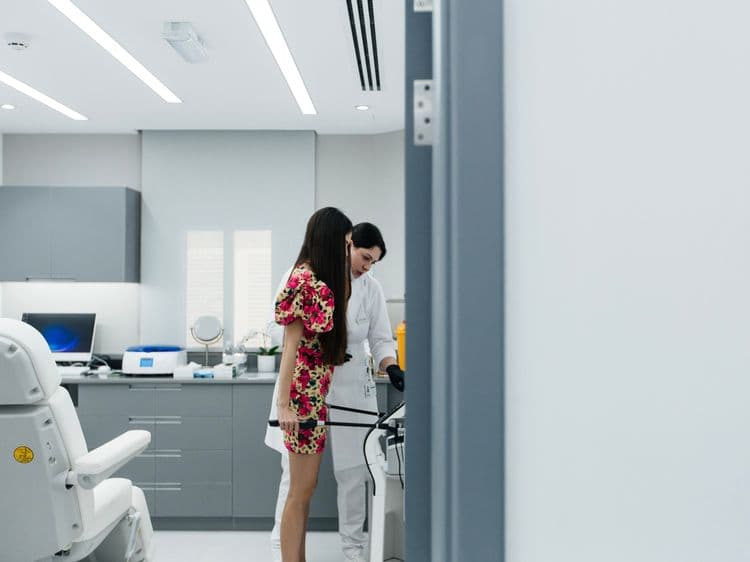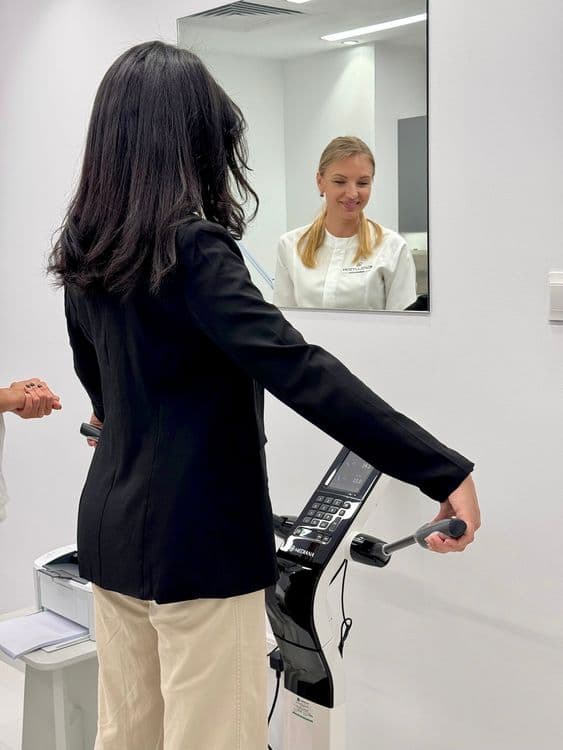Body
Composition Test with GP Doctor

Our Body Composition Test with GP Doctor gives a clear picture of what your weight is made of: fat, muscle, and body water. Using multi-frequency bioelectrical impedance, we measure total body water, intracellular and extracellular water ratio, skeletal muscle mass, fat mass, fat-free mass, protein, and minerals. During the same visit, our GP explains the numbers in plain language and what they mean for your health. You get clear outputs on muscle development, nutritional balance, and obesity degree, not just a BMI. This helps build realistic diet, training, and recovery plans, and to monitor changes over time. The test is quick, non-invasive, and suitable for regular progress checks.
Actionable results in minutes: key benefits of Body Composition Analysis
Beyond BMI: precise breakdown of fat, muscle, and water
Multi-frequency analysis separates fat mass, fat-free mass, and water compartments for targeted decisions.
Results in minutes
Testing and a GP explanation are completed in one visit, so you leave with a plan the same day.
Non-invasive and comfortable
No needles or radiation—just stand on the analyzer and hold the handles for a few minutes.
Reliable progress tracking
Trend reports and segmental analysis help you see real change in muscle and fat over time.
Immediate GP-led advice
Your doctor interprets the data, links it to your health risks, and gives clear next steps.
Year-round testing, no sun limits
No sun-exposure restrictions; do it any season and time of day, with simple preparation.
Data you can trust: how the test works with multi-frequency BIA
We use multi-frequency bioelectrical impedance analysis (BIA). A very small alternating electrical current passes through your body via foot and hand electrodes. Different tissues conduct electricity differently: water-rich muscle conducts well, while fat resists. By measuring resistance and reactance at several frequencies, the device estimates Total Body Water (TBW), splits it into Intracellular Water (ICW) and Extracellular Water (ECW), and calculates Fat-Free Mass (FFM) and Fat Mass (FM). Using your height, weight, age, and sex, validated algorithms model protein, mineral content, skeletal muscle mass, and the ECW ratio, which is useful for hydration and fluid balance review. Segmental analysis (arms, legs, trunk) shows where muscle and fat are distributed. Our GP reviews outputs such as Skeletal Muscle and Fat Analysis (weight, skeletal muscle, body fat) and compares them with previous results to show change. The method is non-invasive and involves no radiation, making it practical for repeat measurements.Contraindications
This test uses a very small electrical current. For some people it is not suitable, and for others results may be unreliable. Please inform the GP if any of the following apply to you.
- Implanted pacemaker or cardioverter-defibrillator (ICD).
- Other implanted electronic devices (e.g., neurostimulator, insulin pump).
- Pregnancy or suspected pregnancy (we usually postpone unless cleared by your obstetrician).
- Open wounds, active dermatitis, or contagious skin conditions on hands or feet where electrodes contact.
- Acute illness with fever, severe dehydration, or recent vomiting/diarrhoea.
- Severe edema, ascites, or heart failure causing major fluid shifts (interpretation may be limited).
- Recent major surgery (within 2 weeks) or immediate postoperative fluid changes.
- Inability to stand or safely hold electrodes; discuss seated or alternative assessments with the GP.

Clear timeline: when to test and how to track progress
Your first visit includes the body composition test plus a GP consultation to set goals and a plan. Most people repeat testing every 4–8 weeks; athletes or those on structured weight programs may re-test every 2–4 weeks to fine-tune training and nutrition. The initial appointment typically takes 30–45 minutes; follow-ups take 15–30 minutes. For the most consistent results: avoid alcohol for 24–48 hours; avoid vigorous exercise for 12–24 hours; do not eat a heavy meal for 2–4 hours; maintain usual hydration; empty your bladder about 30 minutes before; remove metal jewelry; and try to test at a similar time of day each visit. After testing, resume normal eating and hydration and follow the doctor’s recommendations. Your GP may combine the results with blood tests (e.g., glucose, lipids, thyroid) and adjust diet, activity, and recovery plans. Long-term results depend on adherence; regular re-testing keeps you accountable and shows what is working.What goes well with a Body Composition Test?
- Medical Laboratory TestsCombine your body composition data with blood work—lipids, HbA1c, thyroid panel, vitamin D, iron, and inflammation markers. This shows why fat, water, or fatigue are high and sets priorities. Your GP can tailor calories, protein, and training load to these results. Recheck labs in 8–12 weeks to track real metabolic change, not just the scale.
- Food Intolerance TestIf bloating, cravings, or afternoon slumps skew your measurements, screening for food reactions helps build a calmer gut and steadier energy. Use the report to refine macros, fiber, and meal timing. Many people see water balance and waist drop once trigger foods are reduced. Compare new readings after 3–4 weeks to confirm improvements.
- Muscles Body ToningAdding structured muscle‑toning boosts basal metabolism and improves the fat‑to‑muscle ratio shown in your test. Sessions can target weak or underactive areas highlighted by posture and segmental mass. Pair with a protein goal from your GP plan and a sleep target. Retest in 4–6 weeks to see lean mass gains and better metabolic score.
- Pressotherapy of BodyWhen your report shows high extracellular water or leg heaviness, pressotherapy improves lymph flow and reduces fluid retention. This helps circumferences and water balance trend in the right direction while speeding recovery after workouts. It pairs well on rest days. Track before‑and‑after measurements to see quick changes in swelling.
- Cryolipolysis Fat Reduction (Fat Freeze)For stubborn fat pockets that resist diet and training, fat freeze targets zones identified by your measurements and photos. Use it as a focused tool while you keep a calorie plan, steps, and protein on track to prevent rebound. Expect gradual changes over weeks. Re‑measure at 6–8 weeks to confirm a drop in local fat mass.
Loading place details...

